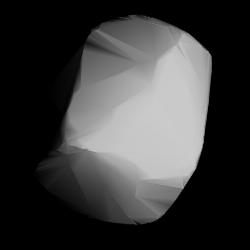Astronomy:1681 Steinmetz
 Shape model of Steinmetz from its lightcurve | |
| Discovery[1] | |
|---|---|
| Discovered by | M. Laugier |
| Discovery site | Nice Obs. |
| Discovery date | 23 November 1948 |
| Designations | |
| (1681) Steinmetz | |
| Named after | Julius Steinmetz (amateur astronomer)[2] |
| 1948 WE · 1926 YA 1936 BE · 1939 VC 1945 ED · 1957 YH 1958 AE · A914 DB | |
| Minor planet category | main-belt · (middle)[3] |
| Orbital characteristics[1] | |
| Epoch 4 September 2017 (JD 2458000.5) | |
| Uncertainty parameter 0 | |
| Observation arc | 103.18 yr (37,688 days) |
| |{{{apsis}}}|helion}} | 3.2486 AU |
| |{{{apsis}}}|helion}} | 2.1443 AU |
| 2.6965 AU | |
| Eccentricity | 0.2048 |
| Orbital period | 4.43 yr (1,617 days) |
| Mean anomaly | 169.22° |
| Mean motion | 0° 13m 21.36s / day |
| Inclination | 7.2063° |
| Longitude of ascending node | 94.373° |
| 1.6555° | |
| Physical characteristics | |
| Dimensions | 14.58±0.75 km[4] 16.159±0.342 km[5] 20.49 km (calculated)[3] |
| Rotation period | 8.99917±0.00007 h[6] |
| Geometric albedo | 0.10 (assumed)[3] 0.161±0.041[5] 0.204±0.024[4] |
| Tholen = S[1] · S[3] B–V = 0.878[1] U–B = 0.447[1] | |
| Absolute magnitude (H) | 11.37±0.33[7] · 11.56[1][3][4][5] |
1681 Steinmetz, provisional designation 1948 WE, is a stony asteroid from the central region of the asteroid belt, approximately 16 kilometers in diameter. It was discovered on 23 November 1948, by French astronomer Marguerite Laugier at Nice Observatory in south-eastern France.[8] It was named after German amateur astronomer Julius Steinmetz.[2]
Orbit and classification
Steinmetz orbits the Sun in the central main-belt at a distance of 2.1–3.2 AU once every 4 years and 5 months (1,617 days). Its orbit has an eccentricity of 0.20 and an inclination of 7° with respect to the ecliptic.[1] Steinmetz was first identified as A914 DB at Heidelberg Observatory in 1914, extending the body's observation arc by 34 years prior to its official discovery observation at Nice.[8]
Physical characteristics
This asteroid is characterized as a common S-type asteroid in the Tholen classification.[1]
Rotation period
In December 2006, Italian amateur astronomer Silvano Casulli obtained a rotational lightcurve of Steinmetz from photometric observations. It gave a well-defined rotation period of 8.99917 hours with a brightness variation of 0.42 magnitude ({{{1}}}).[6]
Diameter and albedo
According to the surveys carried out by the Japanese Akari satellite and NASA's Wide-field Infrared Survey Explorer with its subsequent NEOWISE mission, Steinmetz measures 14.58 and 16.16 kilometers in diameter, and its surface has an albedo of 0.204 and 0.161, respectively.[4][5] The Collaborative Asteroid Lightcurve Link assumes an albedo of 0.10 and calculates a diameter of 20.49 kilometers based on an absolute magnitude of 11.56.[3]
Naming
According to a proposal by Otto Kippes, who verified the discovery, this minor planet was named after Julius Steinmetz (1893–1965), a German amateur astronomer, orbit computer, and pastor from Gerolfingen in Bavaria.[2] The official naming citation was published by the Minor Planet Center on 1 October 1980 (M.P.C. 5523).[9]
References
- ↑ 1.0 1.1 1.2 1.3 1.4 1.5 1.6 1.7 "JPL Small-Body Database Browser: 1681 Steinmetz (1948 WE)". Jet Propulsion Laboratory. https://ssd.jpl.nasa.gov/sbdb.cgi?sstr=2001681. Retrieved 6 June 2017.
- ↑ 2.0 2.1 2.2 Schmadel, Lutz D. (2007). "(1681) Steinmetz". Dictionary of Minor Planet Names – (1681) Steinmetz. Springer Berlin Heidelberg. p. 134. doi:10.1007/978-3-540-29925-7_1682. ISBN 978-3-540-00238-3.
- ↑ 3.0 3.1 3.2 3.3 3.4 3.5 "LCDB Data for (1681) Steinmetz". Asteroid Lightcurve Database (LCDB). http://www.minorplanet.info/PHP/generateOneAsteroidInfo.php?AstInfo=1681%7CSteinmetz. Retrieved 23 December 2016.
- ↑ 4.0 4.1 4.2 4.3 Usui, Fumihiko; Kuroda, Daisuke; Müller, Thomas G.; Hasegawa, Sunao; Ishiguro, Masateru; Ootsubo, Takafumi et al. (October 2011). "Asteroid Catalog Using Akari: AKARI/IRC Mid-Infrared Asteroid Survey". Publications of the Astronomical Society of Japan 63 (5): 1117–1138. doi:10.1093/pasj/63.5.1117. Bibcode: 2011PASJ...63.1117U. (online, AcuA catalog p. 153)
- ↑ 5.0 5.1 5.2 5.3 Masiero, Joseph R.; Mainzer, A. K.; Grav, T.; Bauer, J. M.; Cutri, R. M.; Nugent, C. et al. (November 2012). "Preliminary Analysis of WISE/NEOWISE 3-Band Cryogenic and Post-cryogenic Observations of Main Belt Asteroids". The Astrophysical Journal Letters 759 (1): 5. doi:10.1088/2041-8205/759/1/L8. Bibcode: 2012ApJ...759L...8M. http://adsabs.harvard.edu/cgi-bin/bib_query?bibcode=2012ApJ...759L...8M. Retrieved 23 December 2016.
- ↑ 6.0 6.1 Behrend, Raoul. "Asteroids and comets rotation curves – (1681) Steinmetz". Geneva Observatory. http://obswww.unige.ch/~behrend/page4cou.html#001681. Retrieved 23 December 2016.
- ↑ Veres, Peter; Jedicke, Robert; Fitzsimmons, Alan; Denneau, Larry; Granvik, Mikael; Bolin, Bryce et al. (November 2015). "Absolute magnitudes and slope parameters for 250,000 asteroids observed by Pan-STARRS PS1 - Preliminary results". Icarus 261: 34–47. doi:10.1016/j.icarus.2015.08.007. Bibcode: 2015Icar..261...34V. http://adsabs.harvard.edu/cgi-bin/bib_query?bibcode=2015Icar..261...34V. Retrieved 23 December 2016.
- ↑ 8.0 8.1 "1681 Steinmetz (1948 WE)". Minor Planet Center. https://www.minorplanetcenter.net/db_search/show_object?object_id=1681. Retrieved 23 December 2016.
- ↑ "MPC/MPO/MPS Archive". Minor Planet Center. https://www.minorplanetcenter.net/iau/ECS/MPCArchive/MPCArchive_TBL.html. Retrieved 23 December 2016.
External links
- Asteroid Lightcurve Database (LCDB), query form (info )
- Dictionary of Minor Planet Names, Google books
- Asteroids and comets rotation curves, CdR – Observatoire de Genève, Raoul Behrend
- Discovery Circumstances: Numbered Minor Planets (1)-(5000) – Minor Planet Center
- 1681 Steinmetz at AstDyS-2, Asteroids—Dynamic Site
- 1681 Steinmetz at the JPL Small-Body Database
 |

